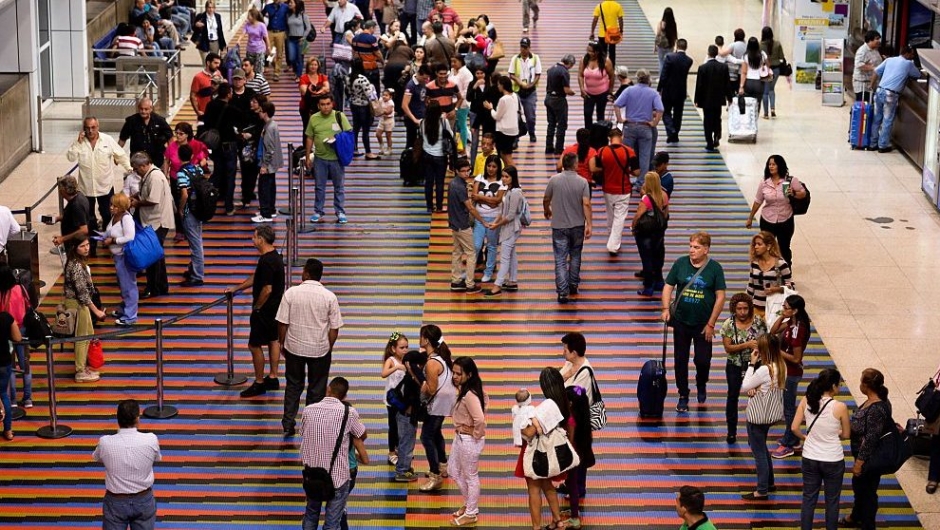( Spanish) — A few weeks after the reestablishment of bilateral relations between Colombia and Venezuela after years of being frozen, on September 26 flights between the two countries will resume as part of the progress in bilateral relations between the two countries, as announced by the governments of Gustavo Petro and Nicolas Maduro.
Both leaders reported that as of September 26, the land borders between Colombia and Venezuela will be reopened and international flights connecting Bogotá and Caracas, and Bogotá and Valencia, will resume.
As of September 26, “we will jointly open the borders between Venezuela and Colombia. In addition, we will resume flights between Caracas – Bogotá and Valencia – Bogotá. The exchange and cooperation between our peoples restart on the right foot,” the president wrote. of Venezuela, Nicolas Maduro, on his Twitter account last September 9.
Petro in turn reported the same: “On September 26 we will open the border between Colombia and Venezuela. As a first step, the air connection and cargo transport between our countries will be resumed. We confirm the Government’s commitment to reestablish brotherly relations.”
The Colombian Interior Minister, Alfonso Prada, said that with the formal reopening of the border between the two countries, a “great integration in terms of cargo, transport, flow and naturally there are the human beings, the Venezuelans who have arrived in Colombian territory”.
“Reclaim that a new day begins with the opening of the border, with the revitalization of our relations on the border”, Prada said at an event in Bogotá on September 9.
Although the two governments made these announcements, the airlines that will connect the two countries are still awaiting authorization from the civil authorities.

Stock image. Passengers are pictured at the Simón Bolívar international airport in Caracas, on June 17, 2016. Flights between Colombia and Venezuela are expected to resume on September 26, 2022 after years of cancellation of direct flights. (Credit: FEDERICO PARRA/AFP via Getty Images)
What we know about the resumption of flights between Colombia and Venezuela
The Colombian Civil Aeronautics reported in July of this year that to two airlines licenses to fly to Venezuela were approved.
One of them is Avianca, which was granted the license to fly on the Bogotá – Caracas – Bogotá route.
The other is Wingo, for which the Bogotá – Valencia – Bogotá route was approved, according to the Civil Aeronautics.
Meanwhile, the National Institute of Civil Aeronautics (INAC) of Venezuela reported on September 9 that authorized flights with Colombia. The INAC did not give more details about which airlines were authorized to fly to Venezuela from Colombia, noting that restrictions on aviation operations are maintained due to the covid-19 pandemic.
For this reason, he said, air operations to Venezuela from a handful of countries such as Turkey, Russia, Mexico, Bolivia, Panama, Iran, Portugal, Cuba, among others, are only allowed “exceptionally”.
The Colombian ambassador to Venezuela, Armando Benedetti, said that the Colombian government advance conversations with Caracas to restore direct flights from airlines such as Avianca, Latam, Ultra and Wingo. In Venezuela, the Avior airline already has approval and Laser Airlines is under review.
Local media cited Wingo airline indicating that as of October 4 they will be available as of October 4 and will connect not only Bogotá with Caracas, but Medellín-Caracas and Bogotá-Valencia. The company is awaiting authorization from Venezuela.
Avianca, meanwhile, obtained authorization from the Colombian Civil Aeronautics to fly from Bogotá to Caracas with a frequency of 7 weekly trips, according to the economic newspaper La República. But they still await authorization from Venezuela.
has reached out to Wingo, Avianca and LATAM for comment.
Currently, only seven international airlines operate in the country. Compared to 2013, the drop is approximately 80%, says ALAV. The lack of supply means that trips can sometimes be very expensive.
















Add Comment